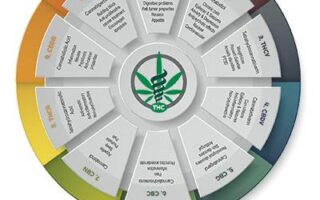In the realm of modern wellness and alternative medicine, cannabis compounds have emerged as enigmatic allies, captivating the attention of researchers, health enthusiasts, and curious minds alike. As society slowly sheds the stigmas of the past, a sophisticated appreciation for the plant’s intricate chemistry is blossoming. Beyond the cannabis plant’s well-known psychoactive properties lies a treasure trove of compounds, each with its unique structure and potential therapeutic benefits. From cannabinoids like THC and CBD to an array of terpenes and flavonoids, these elements work harmoniously, offering a symphony of possibilities for both health and healing. This article sets out to explore the fascinating world of cannabis compounds, delving into their functions, interactions, and the burgeoning science that’s uncovering their secrets. Join us on this journey as we unravel the complexities and curiosities surrounding these remarkable compounds that are redefining our understanding of wellness and natural therapies.
Table of Contents
- Exploring the Unique Chemistry of Cannabis Compounds
- Unlocking the Therapeutic Potential of Cannabinoids
- Terpenes and Their Role in Enhancing Cannabis Benefits
- Navigating the Future of Cannabis: Trends and Innovations in Compound Research
- Q&A
- Closing Remarks
Exploring the Unique Chemistry of Cannabis Compounds
Cannabis is not merely a plant; it’s a complex tapestry of compounds that contribute to its effects, flavor, and therapeutic potential. Among these, cannabinoids, terpenes, and flavonoids play pivotal roles. Each of these compounds interacts with our body’s endocannabinoid system in unique ways, resulting in varied effects. For instance, while THC is known for its psychoactive properties, CBD has garnered attention for its potential to alleviate anxiety without the high. Terpenes, often responsible for the plant’s aroma, can also modulate these effects, contributing to what’s known as the ”entourage effect.” This phenomenon suggests that the synergy of cannabinoids and terpenes may enhance the therapeutic benefits of cannabis.
The diversity of cannabis compounds can be categorized as follows:
- Cannabinoids: These include THC, CBD, CBG, and many others, each exhibiting different properties and potential benefits.
- Terpenes: Found in various plants, terpenes like myrcene, limonene, and pinene not only define the fragrance but can influence the effects and therapeutic applications of cannabis.
- Flavonoids: Responsible for the color of the plant, these compounds also possess antioxidant properties and contribute to health benefits.
Understanding these compounds is crucial for consumers seeking tailored effects or those exploring the medicinal properties of cannabis. Below is a concise overview of some prominent cannabinoids and their characteristics:
| Compound | Primary Effects | Uses |
|---|---|---|
| THC | Euphoria, Appetite Stimulation | Chronic Pain, Nausea |
| CBD | Anti-anxiety, Anti-inflammatory | Epilepsy, PTSD |
| CBG | Neuroprotective, Antibacterial | Glaucoma, Inflammation |
This intricate interplay of cannabis compounds not only enriches the user experience but also opens up new realms of research and application in various fields, from wellness to pharmacology.
Unlocking the Therapeutic Potential of Cannabinoids
The exploration of cannabis compounds has opened new avenues in the realm of therapeutic applications, particularly focusing on cannabinoids. These remarkable compounds, including tetrahydrocannabinol (THC) and cannabidiol (CBD), are increasingly recognized for their potential in treating a variety of health conditions. Research has highlighted their ability to modulate pain, alleviate anxiety, and reduce inflammation, making them compelling alternatives or adjuncts to traditional treatments. As scientists continue to uncover the intricacies of the endocannabinoid system, the promise of these compounds becomes clearer, hinting at their role in achieving homeostasis within the body.
Among the multitude of cannabinoids, the therapeutic benefits appear to be multifaceted, catering to an array of medical conditions. Below is a brief overview of some notable cannabinoids and their potential benefits:
| Cannabinoid | Potential Benefits |
|---|---|
| THC | May relieve pain and stimulate appetite |
| CBD | May reduce anxiety and improve sleep quality |
| CBG | Potential neuroprotective properties |
| CBN | May promote sleep and act as an anti-inflammatory |
The versatility of cannabinoids in therapeutic settings is further accentuated by their non-psychoactive nature in certain instances, particularly with CBD, which has grown in popularity due to its safety profile. As we deepen our understanding of how these compounds operate synergistically, we move closer to unlocking their full medicinal potential, paving the way for innovative treatments and enhanced patient care.
Terpenes and Their Role in Enhancing Cannabis Benefits
Terpenes are aromatic compounds found in various plants, including cannabis, contributing to the unique scents and flavors associated with different strains. Beyond their olfactory contributions, they play a significant role in the therapeutic properties of cannabis. Some of the most common terpenes include:
- Myrcene: Known for its sedative effects, often linked to relaxation and sleep.
- Limonene: Often uplifting, it may help elevate mood and reduce stress.
- Caryophyllene: Recognized for its anti-inflammatory properties and potential in pain management.
- Pinene: May assist with alertness and memory retention while providing potential anti-inflammatory benefits.
The entourage effect is a term used to describe how terpenes and cannabinoids work synergistically to enhance the overall effects of cannabis. Research suggests that when terpenes interact with cannabinoids like THC and CBD, they can modify or intensify their effects, leading to a more rounded and beneficial experience. For example, a strain high in Myrcene may not only promote relaxation but could also increase the potency of THC, intensifying its psychoactive effects. Understanding the unique terpene profiles of different cannabis strains allows consumers to tailor their experience to their specific needs and preferences.
Navigating the Future of Cannabis: Trends and Innovations in Compound Research
The exploration of cannabis compounds is entering an unprecedented phase, fueled by technological advancements and a growing recognition of their therapeutic potential. Researchers and innovators are delving into the unique cannabinoid profiles found in different strains, uncovering a treasure trove of possibilities for industry applications. This newfound focus on cannabinoid diversity is paving the way for more targeted medical solutions, allowing for personalized treatment regimens tailored to individual needs. As a result, we are beginning to see a shift towards data-driven approaches, where scientific evidence underpins product development and marketing strategies.
Emerging trends indicate a surge in biotechnology and synthetic biology research, which could redefine how we cultivate and utilize cannabis compounds. This includes methods such as gene editing and fermentation to produce cannabinoids in controlled environments, radically enhancing consistency and potency without the traditional agricultural challenges. Additionally, innovative delivery systems—such as nanotechnology and transdermal patches—are being developed to improve the bioavailability of cannabinoids, ensuring users receive maximum benefit. To better understand and visualize these advancements, consider the following table:
| Trend/Innovation | Impact on Industry |
|---|---|
| Biotechnology | Enhances production efficiency and compound consistency |
| Nanotechnology | Increases bioavailability for better therapeutic outcomes |
| Synthetic Biology | Reduces reliance on traditional farming methods |
Q&A
Q&A: Understanding Cannabis Compounds
Q1: What are cannabis compounds?
A1: Cannabis compounds are the various chemical constituents found within the cannabis plant. The most notable of these are cannabinoids, terpenes, and flavonoids. Cannabinoids like THC (tetrahydrocannabinol) and CBD (cannabidiol) interact with our body’s endocannabinoid system, while terpenes and flavonoids contribute to the plant’s aroma, flavor, and potential therapeutic benefits.
Q2: What is the difference between cannabinoids and terpenes?
A2: Cannabinoids are the active compounds that primarily affect our body’s receptors and can produce psychoactive effects (like THC) or therapeutic benefits (like CBD). Terpenes, on the other hand, are aromatic compounds that give cannabis its distinctive smells and flavors. They may also enhance or alter the effects of cannabinoids through a phenomenon known as the entourage effect, creating a more complex experience than cannabinoids alone.
Q3: Are all cannabinoids psychoactive?
A3: No, not all cannabinoids are psychoactive. THC is well-known for its psychoactive effects, which can result in feelings of euphoria or altered perception. In contrast, CBD is non-psychoactive and is often sought after for its therapeutic properties without the “high” associated with THC. Other cannabinoids like CBG (cannabigerol) and CBN (cannabinol) also exist, each with its own potential effects and benefits.
Q4: Can you explain the entourage effect?
A4: The entourage effect is the synergistic interaction between cannabinoids, terpenes, and flavonoids that may enhance the overall therapeutic benefits of cannabis. Studies suggest that a full-spectrum cannabis product—containing a variety of compounds rather than a single isolated compound—can be more effective than isolated cannabinoids alone. This phenomenon highlights the importance of the whole plant in therapeutic contexts.
Q5: How are cannabis compounds extracted?
A5: Cannabis compounds can be extracted using various methods, including solvent extraction, CO2 extraction, and steam distillation. Each technique has its own advantages and limitations. For instance, CO2 extraction is favored for its efficiency and ability to yield high purity products, while solvent extraction can be simpler but carries potential risks associated with residual solvents. Quality control is crucial during extraction to preserve the integrity and potency of the compounds.
Q6: What potential benefits do these compounds offer?
A6: Cannabis compounds have been studied for a variety of potential benefits. THC may help alleviate pain, stimulate appetite, and reduce nausea, particularly in medical contexts such as cancer treatment. CBD is being researched for its anti-inflammatory, anti-anxiety, and seizure-reducing properties. Terpenes, depending on their type, may offer additional benefits, such as calming effects from linalool or uplifting effects from limonene, creating a spectrum of therapeutic possibilities.
Q7: Are there any risks associated with cannabis compounds?
A7: While many people find therapeutic benefits from cannabis, risks do exist. The psychoactive effects of THC can lead to anxiety, paranoia, or impaired judgment, particularly in inexperienced users or in high doses. Additionally, the legality of cannabis and its compounds varies widely, affecting access and use. It’s important for individuals to consult with healthcare professionals and consider their personal health circumstances when exploring cannabis options.
Q8: How can consumers choose the right cannabis product for their needs?
A8: Selecting the right cannabis product requires understanding both personal goals and product composition. Consumers should consider factors such as cannabinoid ratios (e.g., CBD to THC), specific terpenes present, and personal preferences regarding method of consumption (e.g., smoking, edibles, oils). Researching product lab results and consulting knowledgeable dispensary staff can also aid in making informed choices. It’s always wise to start with a lower dose, especially if new to cannabis, to gauge individual reactions.
Q9: Is future research on cannabis compounds likely?
A9: Yes, the future of cannabis research is promising. As societal attitudes toward cannabis continue to evolve and legal barriers are lifted, more studies are delving into the medicinal properties of cannabis compounds. Researchers are exploring everything from specific strain effects to the impact of terpenes on mood and well-being. This burgeoning field holds the potential for new therapeutic applications and greater understanding of how cannabis interacts with the human body.
Q10: Where can I learn more about cannabis compounds?
A10: For those seeking more information about cannabis compounds, reputable online resources, academic journals, and books on herbal medicine are excellent starting points. Engaging with licensed dispensaries and consulting healthcare professionals knowledgeable in cannabis can also provide tailored information to help individuals navigate this complex and evolving landscape. Whether you’re a novice or a seasoned explorer of cannabis, the journey of discovery awaits!
Closing Remarks
As we delve into the world of cannabis compounds, we uncover a rich tapestry of chemical interactions that shape not only the plant itself but also its impact on human health and wellness. From the well-studied cannabinoids like THC and CBD to the lesser-known terpenes and flavonoids, each compound plays a distinct role in the multifaceted experience of cannabis consumption.
As research continues to evolve, so too does our understanding of these intricate compounds. The future holds exciting possibilities for therapeutic applications and the potential to harness cannabis for a variety of health benefits.
Whether you’re a seasoned enthusiast or a casual observer, the exploration of cannabis compounds invites us to rethink our relationship with this ancient plant. As we close this chapter, remember that knowledge is the first step towards informed decision-making—so keep questioning, keep learning, and let curiosity guide you on the path to discovery.



